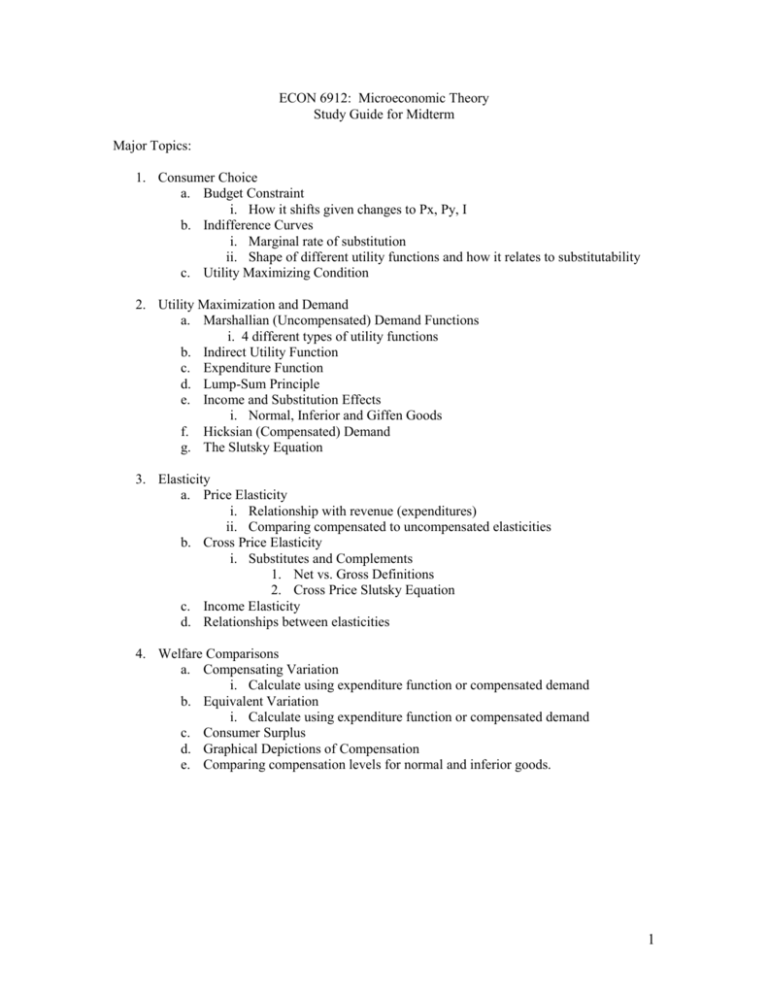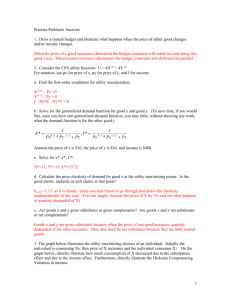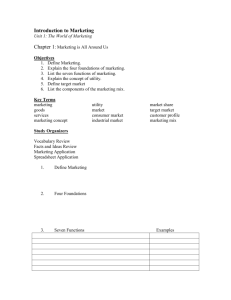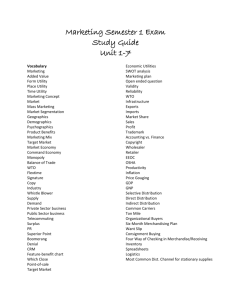Study Guide for Exam 1
advertisement

ECON 6912: Microeconomic Theory Study Guide for Midterm Major Topics: 1. Consumer Choice a. Budget Constraint i. How it shifts given changes to Px, Py, I b. Indifference Curves i. Marginal rate of substitution ii. Shape of different utility functions and how it relates to substitutability c. Utility Maximizing Condition 2. Utility Maximization and Demand a. Marshallian (Uncompensated) Demand Functions i. 4 different types of utility functions b. Indirect Utility Function c. Expenditure Function d. Lump-Sum Principle e. Income and Substitution Effects i. Normal, Inferior and Giffen Goods f. Hicksian (Compensated) Demand g. The Slutsky Equation 3. Elasticity a. Price Elasticity i. Relationship with revenue (expenditures) ii. Comparing compensated to uncompensated elasticities b. Cross Price Elasticity i. Substitutes and Complements 1. Net vs. Gross Definitions 2. Cross Price Slutsky Equation c. Income Elasticity d. Relationships between elasticities 4. Welfare Comparisons a. Compensating Variation i. Calculate using expenditure function or compensated demand b. Equivalent Variation i. Calculate using expenditure function or compensated demand c. Consumer Surplus d. Graphical Depictions of Compensation e. Comparing compensation levels for normal and inferior goods. 1 Practice Problems Note: The test will consist of approximately 10 short answer questions. The practice problems below are just intended to help you study for some of the types of questions you’ll be asked on the exam, and is not intended to be at all exhaustive. You should also use your class notes, the assignments, and your textbook as study tools. Good luck and enjoy the questions! 1. Draw a typical budget and illustrate what happens when the price of either good changes and/or income changes. 2. Consider the CES utility function: U = 4X.25 + 4Y.25 For notation, use px for price of x, py for price of y, and I for income. a. Find the first-order conditions for utility maximization. b. Solve for the generalized Marshallian demand function for good x and good y. Assume the price of x is $16, the price of y is $16, and income is $480. c. Solve for x*, y*, U*. d. Calculate the price elasticity of demand for good x at the utility maximizing points. Is the good elastic, inelastic or unit elastic at that point? e. Are goods x and y gross substitutes or gross complements? Are goods x and y net substitutes or net complements? 3. The graph below illustrates the utility maximizing choices of an individual. Initially the individual is consuming X0; then price of X increases and the individual consumes X1. On the graph below, directly illustrate how much consumption of X decreased due to the substitution effect and due to the income effect. Furthermore, directly illustrate the Hicksian Compensating Variation in income. Y U0 U1 X1 X0 X 2 4. On the graph below, depicting the same situation directly illustrate the Hicksian Equivalent Variation in income. Y U0 U1 X1 X0 X 4a.) Does the graph above depict a normal or inferior good? Are good X and Y substitutes or complements? 5) A student spends 8 hours per day listening to music, with M hours devoted to Mozart, and B hours devoted to Beethoven. The student’s utility function is given by U=M0.25B0.75 Explain whether the following statement True, False, or Uncertain: The utility maximizing listening pattern of this student will generate four times as much listening to Beethoven as listening to Mozart. 6) Suppose currently Sophie consumes 15 units of X and 12 units of Y. The price of X is $3 and the price of Y is $6. Her current marginal utility of X is 21 utils. a.) If she is currently maximizing utility, what is her marginal utility of Y? b.) What does her marginal utility of income equal? 7) Assume that utility is given by U=X0.3Y0.7 a.) Calculate the indirect utility function. b.) Calculate the expenditure function. c.) Calculate the compensated demand function. 3 8) A hot dog vendor faces a daily demand curve of Q=1800-15P, where P is the price of a hot dog in cents and Q is the number of hot dogs purchased each day. a. If the vendor has been selling 300 hot dogs each day, how much revenue has he been collecting? b. What is the price elasticity of demand for hot dogs? c. The vendor decides that he want to generate more revenue. Should he raise or lower the price he charges for hot dogs? d. At what price would the vendor achieve the maximum total revenue? 9) Suppose the price of oil suddenly rises from $100/barrel to $110/barrel. As a result, total expenditures on oil increase from $300 million/day to $320 million/day. What is the price elasticity of demand for oil? 10) List and briefly explain whether the following good X is Normal, Inferior, a Giffen good, or Indeterminate. a.) The price of good X increases from $30 to $35. Uncompensated demand changes from X 0 80 to X 1 =75. Compensated demand changes from X 0C 80 to X 1C =76. b.) X C 0 PX c.) Price increases, and the Hicksian Compensating Variation is less than the change in Consumer Surplus. 11. Describe in words what the Compensating Variation for a price increase is and how to find it. Do the same for the Equivalent Variation. X Y X C 0 .1 ; X * 0.15 12. Suppose: 0.2 ; Y * I I PY a.) Is X a gross substitute or complement of Y? How do you know? b.) Is X a net substitute or complement of Y? How do you know? c.) Is X a normal or inferior good? How do you know? d.) What does Y equal? Px 4








